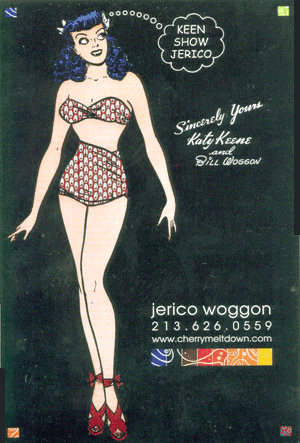



KATY KEENE AND BILL WOGGON, STRAIGHT UP
by Maureen Foley
Bill Woggon, a cartoonist, created a devilishly stylish character named
Katy Keene in 1945. Though Woggon’s career would ultimately take many
twists and turns, it was Katy who remained his greatest success. From 1949
to 1961, Archie Comics published the Katy Keene comic book to thousands of
adoring teen-age fan. In each issue, Woggon chronicled Katy’s adventures
with boys, clothes and her little sister. But it was his choice to incorporate
the fashion designs of his young readers, and give them credit, in each story
that guaranteed Katy’s success.
In 2005, Katy Keene turned 60 (although Bill Woggon passed away in
2003) That winter, Maureen Foley, a freelance writer and artist, interviewed
a few members of Woggon’s family to finally get the low-down on Bill
and Katy. Foley talked to two of Bill’s children, Susie Bothke (the
inspiration for Katy’s sister, Sis the Candy Kid) and Bill Woggon,
Jr., and his grandson, Jerico Woggon. For the first time, fans can
read about their favorite cartoonist and comic book character, as told by
his family.
MAUREEN FOLEY: How did your dad, Bill Woggon, get involved with comics?
BILL WOGGON, JR.: My dad quit school when he was in the 11th grade,
from what I recall, and he went to work at the Toledo Blade, where his older
brother, Elmer Woggon, was the art director. In those days, they drew pictures
of things that were on sale, and my dad went to work for that. He had no
training. He was just a natural artist with a God-given talent. So, he went
to work [drawing for the Toledo Blade]. He also had two younger brothers
who also had talent and went to work for the newspapers. Eventually Elmer
developed a relationship with Allen Saunders. He and Uncle Elmer created
this character called Chief Wahoo. Allen Saunders was the artist and my uncle
was the cartoonist. There was a number of comic strips. Eventually, my dad
started working with my uncle. He would ink the borders and the letters.
MF: How did your dad create Katy Keene? Was Katy based on anyone in
particular? Were the other characters based on anyone?
BILL WOGGON, JR.:During the war years, there were many pin-ups of young
women for calendars and young G.I.s would have these characters. No
one could ever get a definitive answer [from Dad] about who [Katy Keene]
was, although other characters were patterned or taken over by [real
people]. Katy’s boyfriend, K.O. Kelly, a boxer, was fashioned
after my grandfather. Sis the Candy Kid, was after my sister Susie
and Gloria, Katy’s rival, was patterned after my mother. But
Katy herself was just a creation. My dad wrote the strip and did the
cartooning. Unlike my Uncle Elmer, my dad did it all. It started in
1945.
MF: How did your dad get the idea to get his fans involved in designing
Katy’s outfits? Was there another artist doing that?
BILL WOGGON, JR.:He was the only one creating a comic strip who sort
of involved the kids… [Katy] was a model aspiring to be an actress.
Someone else was doing it but he ended up taking it to a further degree.
[Katy] was always wearing these neat clothes. Kids would send in their
drawings. He would take the drawing and no matter how good the drawing
was, re-draw it but keep it as close as possible to what [the child]
wanted to do. [The kids] would see their name and they started fan
clubs and pen pals.
MF: What was his relationship to his fans?
SUSIE BOTHKE: He affirmed [his fans] in their creative ability but
also warned them that they should do something else [besides art] as
well. He listed enough of an address [when he published the drawings
created by young fans in Katy Keene] so that they could be pen pals.
[You would look in each issue to] check to see if your artwork gets
in there.
MF: Did any fans get involved in art careers, based on Bill Woggon’s
encouragment?
BILL WOGGON, JR.: The great part about all of this was that there were
half a dozen kids were were extremely talented and wise. They came
to our house in Santa Barbara and would visit. What we found out is
that these kids ended up in careers in the arts, directors of art departments
or interior designers. One of the highlights of my dad’s career
was the kids that went into art because of his encouragement they got
from my father and the comic book. Trina Robbins, John Lucas, [for
instance]. Floyd Norman was an African-American kid who lived in Santa
Barbara. He was reading the comic book and came to visit my dad. He
applied for a job. He started out inking and doing borders. He went
on to work for Walt Disney and Hanna Barbera. He was 16 or 17 [when
he worked for dad].
MF: How did your family end up on the Woggon Wheels Ranch, in Santa
Barbara?
BILL WOGGON, JR.: Dad moved the family from Ohio to California. In
1948, the family [took a vacation to California] to see MGM studio
and and to tour other studios. We came out on vaction [and to research
Hollywood for the Katy Keene comic book.] We took a side trip to Santa
Barbara. Back in Ohio, we took a family vote and decided to move from
Ohio to California. After we moved to California, more of the [Katy
Keene’s] script took place in Hollywood.